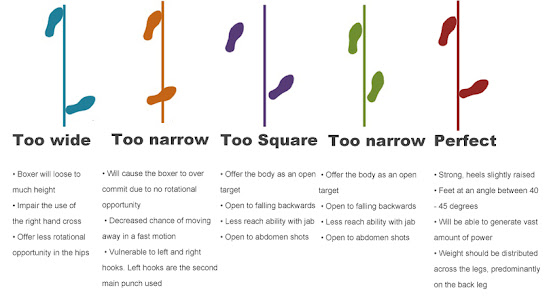First and foremost though, I guess I should explain what the heck I am even talking about. As you may know, there is a particular way that boxers like to stand when they fight. It involves their non-dominant foot forward and their dominant foot back. It is a staggered stance that gives them the ability to move in all directions quickly and keep the hips oriented towards their target. But how far away should the feet be? And what way should the toes be turned? This is where the debate can kick in. Here is a general diagram of different foot positions that I have used in the past but I actually do not agree with its representation of "perfect". AND there are many more permutations that I have seen coached where the front foot is turned more to the right and the back foot is turned more forward.
In fact, there are many reputable teachers who will tell you that your front foot MUST be turned at least 45 degrees to the inside (more than any of these images show). I definitely don't agree with that one personally, but it works for many great boxers so it should not be discounted. The problem I have with "Perfect" up above is that both feet are too close to that line, which in my opinion is too narrow. And I don't like narrow for teaching boxing to brand new people because of something I have discussed several times before: the hardest thing to teach, by far, is how to use their whole body to throw punches. Most new folks only use the upper body while the legs and hips remain frozen. Getting them to use the hips and the legs can be a real challenge. What a wider, more square, stance does is give them better balance in all directions and allow them to shift their weight from the left foot to the right and vice versa, which is the essence of just about everything we do in boxing.
Looking at that diagram, I myself lean towards "Too Square". To me, that is just a better stance for learning and a better stance for power. And looking at the bullet points below, I honestly have no idea what they are talking about other than the very first one ("Offer the body as an open target"). It is true that a squarer stance opens up the body, but this may depend a little bit on you, your style, and your build. Some of the greatest technical boxers ever use that stance - Tyson, Canelo, Innoue and Lomachenko to name a few - and good luck finding footage of them taking a lot of body shots. So while technically accurate, it may not actually be in practice depending on the boxer. The next two make no sense to me. I don't feel any more open to falling backwards as long as my feet are staggered (and I turn my back foot out a little more) and not totally square and can jab just as far in the Too Square stance. Then the last bullet point is just a repeat of the first one.
Here is a video where I further discuss my stance on stances: https://www.youtube.com/watch?v=-Hm9JD-vrfs&t=9s
As a good test, I recommend getting into your boxing stance and having someone push you in 4 directions - forward, back, left and right. You should be able to resist each push equally. If you find you can resist really well in some directions and not others, I think you need a squarer stance than you currently have. Another test is to get down as low as you can and try to shadow box. If you feel really off balance, I would say that your feet are too close together.
When I have seen this discussed online, sometimes the conversation can get muddied up by kickboxing and MMA stances. They are different from traditional boxing stances and what I often read is someone chiming in and talking about versions of the Too Square stance above being better for kickboxing or MMA. This is actually true, in my opinion, but it does NOT that it can't be a boxing stance too. Plenty of boxers use it, including the ones I named earlier. It may not be the best one for you and your particular style but going back to my original point, different boxers have different stances that work for them and that is okay.
Be wary of anyone who claims that their way is the only way for anything. Or that if you do X, Y will happen and that's it. Y is not always true and as sweet scientists, we should always be questioning and learning. The sweet science is never settled. There are strong fundamentals and guidelines - and I recommend everybody at least learn "the rules" before thinking about breaking them. Then stay humble and always be open to things that are new and different, even if you initially disagree.






No comments:
Post a Comment